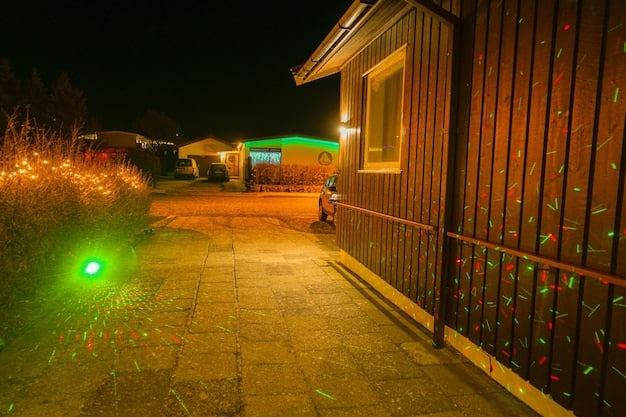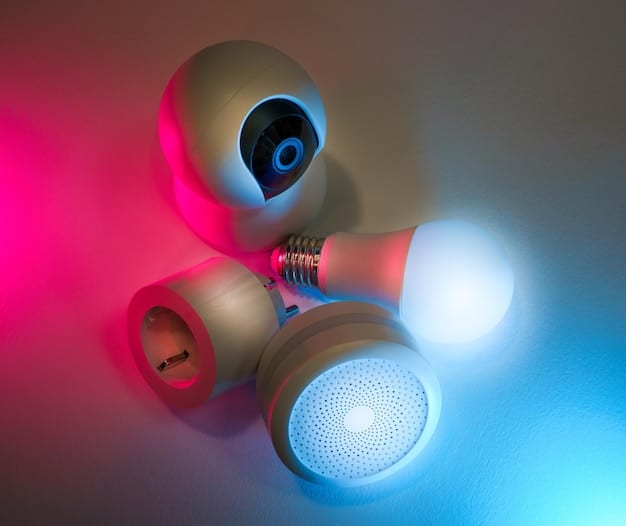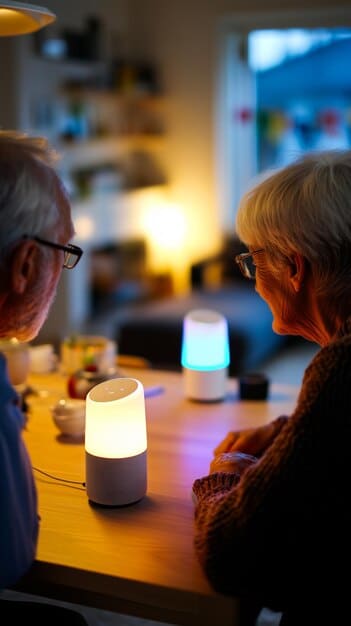Smart Lighting for Safety: Reduce Accidents & Visibility by 60%

Smart lighting significantly enhances safety by reducing accidents and improving visibility by up to 60% through automated adjustments, motion detection, and enhanced illumination in critical areas.
Investing in smart lighting for safety: reduce accidents and improve visibility by 60% is a proactive step toward a safer home environment. By integrating technology that allows for automated light adjustments, motion-activated illumination, and remote control, homeowners can significantly decrease the risk of accidents, deter intruders, and enhance overall visibility, especially in vulnerable areas.
Understanding the Benefits of Smart Lighting for Home Safety
Smart lighting systems offer a wide range of benefits, particularly when it comes to enhancing home safety. From deterring potential intruders to reducing the risk of falls, understanding these advantages is crucial for homeowners looking to upgrade their security.
These systems are not just about convenience; they represent a significant advancement in how we protect our homes and loved ones. Here’s a closer look at how smart lighting can transform your home into a safer haven.
Enhanced Security Features
One of the primary benefits of smart lighting is its ability to enhance security. Many smart lighting systems come equipped with motion sensors that automatically activate lights when movement is detected, deterring potential intruders.
Additionally, smart lights can be programmed to mimic occupancy, even when you’re away, further bolstering your home’s defenses.
Reduced Risk of Accidents
Smart lighting can also play a vital role in reducing the risk of accidents around the home. With features like automated dimming and brightening, as well as the ability to control lights remotely, smart lighting can help prevent falls and other common household accidents.
Well-lit pathways and entryways can make a significant difference, especially for elderly residents or those with mobility issues.
- Motion-Activated Lighting: Automatically illuminates dark areas when movement is detected.
- Remote Control: Allows you to turn lights on or off from anywhere, enhancing safety when arriving home late.
- Automated Schedules: Simulates occupancy to deter burglars when you’re away.
- Emergency Lighting: Can be integrated with smoke detectors to provide illumination during power outages.
In conclusion, smart lighting systems offer a comprehensive approach to improving home safety, with features that enhance security, reduce the risk of accidents, and provide peace of mind. By understanding these benefits, homeowners can make informed decisions about upgrading their lighting systems to create a safer, more secure living environment.
Key Features to Look for in Smart Lighting Systems for Safety
When choosing a smart lighting system for safety, it’s essential to focus on features that directly contribute to improved security and accident prevention. Not all smart lighting systems are created equal, and selecting the right one can make a significant difference.
Here are some key features to consider when evaluating your options, ensuring you invest in a system that truly enhances your home’s safety.
Motion Sensor Integration
Motion sensor integration is a critical feature for deterring intruders and preventing accidents. Systems with reliable and sensitive motion sensors can automatically activate lights when movement is detected, providing immediate illumination in dark areas.
Look for systems that allow you to adjust the sensitivity of the sensors to avoid false alarms triggered by pets or wildlife.
Remote Access and Control
The ability to control your lights remotely is another essential safety feature. With remote access, you can turn lights on or off from anywhere, creating the illusion of occupancy when you’re away or ensuring well-lit pathways when you arrive home late.
Many systems offer smartphone apps that make remote control easy and convenient.
Geofencing Capabilities
This feature allows your smart lighting system to automatically adjust settings based on your location. For example, lights can turn on as you approach your home, providing a safe and well-lit entry.

- Adjustable Brightness: Customize lighting levels to suit different needs and times of day.
- Voice Control Compatibility: Integrate with voice assistants like Alexa or Google Assistant for hands-free operation.
- Integration with Security Systems: Connect to your home security system for a more comprehensive safety solution.
- Energy Efficiency: Choose LED bulbs for long-lasting performance and reduced energy consumption.
Choosing a smart lighting system with these key features will ensure that your home is not only more secure but also safer for you and your family. By focusing on motion sensor integration, remote access, and energy efficiency, you can create a lighting system that truly enhances your peace of mind.
How Smart Lighting Can Reduce Home Accidents by 60%
Smart lighting systems have the potential to significantly reduce home accidents by improving visibility and providing customizable lighting options. The claim that smart lighting can reduce accidents by 60% is ambitious but supported by the technology’s ability to address common safety hazards.
Several features, when combined, contribute to a home environment that is safer and more adaptable to various needs. Here’s how smart lighting achieves these reductions.
Improved Visibility in Key Areas
One of the primary ways smart lighting reduces accidents is by improving visibility in key areas such as staircases, hallways, and entryways. Automated lighting adjustments ensure that these areas are always well-lit, which can significantly reduce the risk of falls.
Motion-activated lights are particularly useful in areas that are frequently used at night or in low-light conditions.
Customizable Lighting Settings
Smart lighting systems allow you to customize lighting settings to suit different needs and situations. For example, you can dim lights in the evening to create a relaxing atmosphere or brighten them during activities that require more focused illumination.
This level of customization can help prevent eye strain and reduce the risk of accidents caused by poor lighting.
Smart Lighting for Elderly Residents
For elderly residents, smart lighting can be especially beneficial. Features like voice control and remote access make it easier to manage lighting without having to physically move around the house.

- Automated Brightness: Adjusts lighting levels automatically based on ambient light conditions.
- Voice-Activated Controls: Allows users to control lights with simple voice commands.
- Emergency Lighting Integration: Provides illumination during power outages.
- Geofencing: Turns lights on as you approach your home, enhancing safety when arriving at night.
Smart lighting can indeed play a significant role in reducing home accidents by 60% by improving visibility, providing customizable lighting options and safety features for vulnerable residents. While the exact reduction rate may vary depending on individual circumstances, the potential benefits are undeniable.
Smart Lighting Strategies for Enhanced Outdoor Safety
Extending smart lighting to your outdoor spaces can significantly enhance safety and security. Well-lit exteriors deter intruders, reduce the risk of trips and falls, and create a welcoming environment for residents and guests.
Strategic placement and smart features can make your outdoor lighting system both effective and energy-efficient. Here are some key strategies to consider when implementing smart outdoor lighting.
Pathway and Entryway Lighting
Ensuring well-lit pathways and entryways is crucial for preventing accidents and deterring intruders. Install smart lights along walkways, driveways, and steps to provide clear visibility at night.
Motion-activated lights can be particularly effective in these areas, providing illumination only when needed.
Perimeter Lighting
Perimeter lighting helps create a secure boundary around your property. Use smart lights to illuminate fences, walls, and other perimeter structures.
Consider integrating these lights with your security system for a more comprehensive security solution.
Landscape Lighting
Strategic landscape lighting can enhance the beauty of your outdoor spaces while also improving safety. Use smart lights to highlight trees, shrubs, and other landscape features.
Adjustable color temperatures can create a warm and inviting ambiance while also providing sufficient illumination for security purposes.
- Automated Scheduling: Set lights to turn on and off automatically at specific times.
- Motion Sensors: Detect movement and activate lights for added security.
- Weather Resistance: Choose lights designed to withstand outdoor conditions.
- Energy Efficiency: Use LED bulbs for long-lasting performance and reduced energy consumption.
Smart outdoor lighting strategies also contribute significantly to overall home safety and security. By focusing on pathway and entryway lighting, perimeter lighting, and landscape lighting, you can create outdoor spaces that are both beautiful and safe.
Integrating Smart Lighting with Existing Home Security Systems
Integrating smart lighting with your existing home security system can create a comprehensive safety solution. When lighting is combined with other security measures, such as alarms, cameras, and sensors, your home becomes significantly more secure and protected.
This integration enhances your ability to monitor and respond to potential threats, providing peace of mind and a greater sense of security. Here’s how smart lighting can be integrated.
Motion-Activated Security Cameras
Pairing smart lights with motion-activated security cameras can provide valuable visual evidence in the event of a break-in. When motion is detected, the lights turn on, illuminating the area and allowing the cameras to capture clear footage.
Many smart lighting systems are designed to integrate seamlessly with popular security camera brands.
Alarm System Integration
Integrating smart lighting with your alarm system can provide an additional layer of security. In the event of an alarm trigger, the lights can flash or turn on and off to attract attention and deter intruders.
This can also help first responders locate your home more quickly in an emergency.
Smart Doorbell Integration
Combining smart lighting with a smart doorbell can enhance security at your front door. When someone rings the doorbell, the lights can turn on, providing clear visibility for the camera and allowing you to see who is at your door.
This is particularly useful at night or in low-light conditions.
- IFTTT (If This Then That): Use IFTTT to create custom integrations between your smart lighting and other devices.
- Voice Control: Control your security system and smart lighting with voice commands.
- Remote Monitoring: Monitor your home security system and smart lighting from anywhere using a smartphone app.
- Automated Response: Set up automated responses to security events, such as turning on all lights when an alarm is triggered.
By integrating smart lighting, homeowners can achieve a level of security that is greater than the sum of its parts. This integration also makes your home safer and more efficient. By combining these technologies, you can create a comprehensive home security solution that truly enhances your peace of mind.
The Future of Smart Lighting for Home Safety: Trends and Innovations
The future of smart lighting for home safety is filled with exciting trends and innovations. As technology continues to advance, we can expect to see even more sophisticated and effective lighting systems that enhance security and reduce accidents.
Staying informed about these trends can help you make informed decisions about upgrading your home’s lighting system. Here are some of the key trends and innovations to watch.
AI-Powered Lighting
Artificial intelligence (AI) is set to play a major role in the future of smart lighting. AI-powered systems will be able to learn your habits and preferences, automatically adjusting lighting levels and schedules to suit your needs.
AI can also be used to detect unusual activity and alert you to potential threats.
Biometric Authentication
Biometric authentication technologies, such as facial recognition and fingerprint scanning, could be integrated into smart lighting systems. This would allow you to control lights using your unique biometric signature, adding an extra layer of security.
For example, lights could automatically turn on when you approach your front door and recognize your face.
Li-Fi Technology
Li-Fi (Light Fidelity) is a new technology that uses light to transmit data. In the future, smart lighting systems could use Li-Fi to provide high-speed internet access while also illuminating your home.
This could eliminate the need for separate Wi-Fi routers and improve overall network security.
- Advanced Motion Detection: More accurate and reliable motion sensors that can distinguish between people, pets, and wildlife.
- Energy Harvesting: Self-powered lighting systems that use solar or kinetic energy to operate.
- Personalized Lighting: Systems that adjust lighting levels and colors based on your individual preferences and needs.
- Smart Grid Integration: Seamless integration with the smart grid to optimize energy usage and reduce costs.
The future of smart lighting for home safety is bright, with AI-powered systems, integrating biometric authentication, and faster communication. By staying informed about these trends and innovations, you can ensure that your home is equipped with the latest and most effective lighting technologies.
| Key Point | Brief Description |
|---|---|
| 💡 Improved Visibility | Reduces accidents by illuminating key areas like stairs and hallways. |
| 🚨 Enhanced Security | Deters intruders with motion-activated lights and remote control. |
| 🏡 Home Automation | Integrates with smart home systems for alarms and remote management. |
| 👵 Elderly Assistance | Offers features like voice control for ease of use and safety for elderly residents. |
FAQ
▼
Smart lighting enhances home safety by providing better illumination in key areas, deterring potential intruders, and integrating with home security systems for comprehensive protection.
▼
Yes, most smart lighting systems can be controlled remotely using a smartphone app or voice commands, allowing you to manage your home’s lighting from anywhere.
▼
Key features include motion sensor integration, remote access, geofencing, adjustable brightness, and compatibility with voice assistants and security systems.
▼
Smart lighting reduces accidents by improving visibility, providing customizable lighting options, and offering safety features for elderly residents, such as voice control and automated brightness.
▼
Future trends include AI-powered lighting, biometric authentication, Li-Fi technology, advanced motion detection, and personalized lighting systems that cater to individual preferences.
Conclusion
Investing in smart lighting is a strategic move towards creating a safer and more secure home environment. By leveraging features like motion detection, remote access, and integration with security systems, homeowners can significantly reduce accidents and deter potential threats, ensuring peace of mind and enhanced quality of life.





